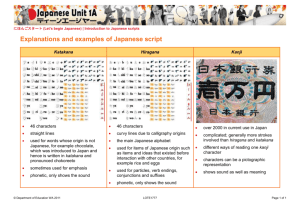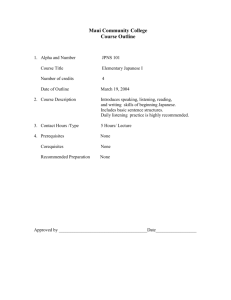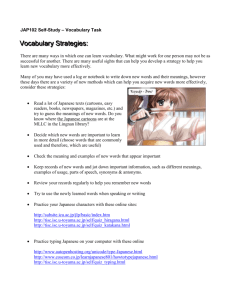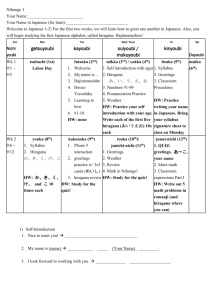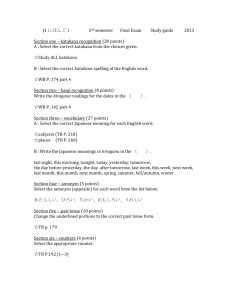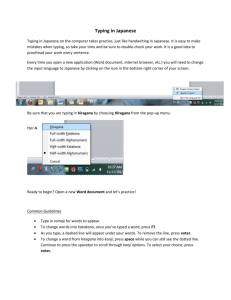Yr8 JAPANESEGreetings_UBD
advertisement
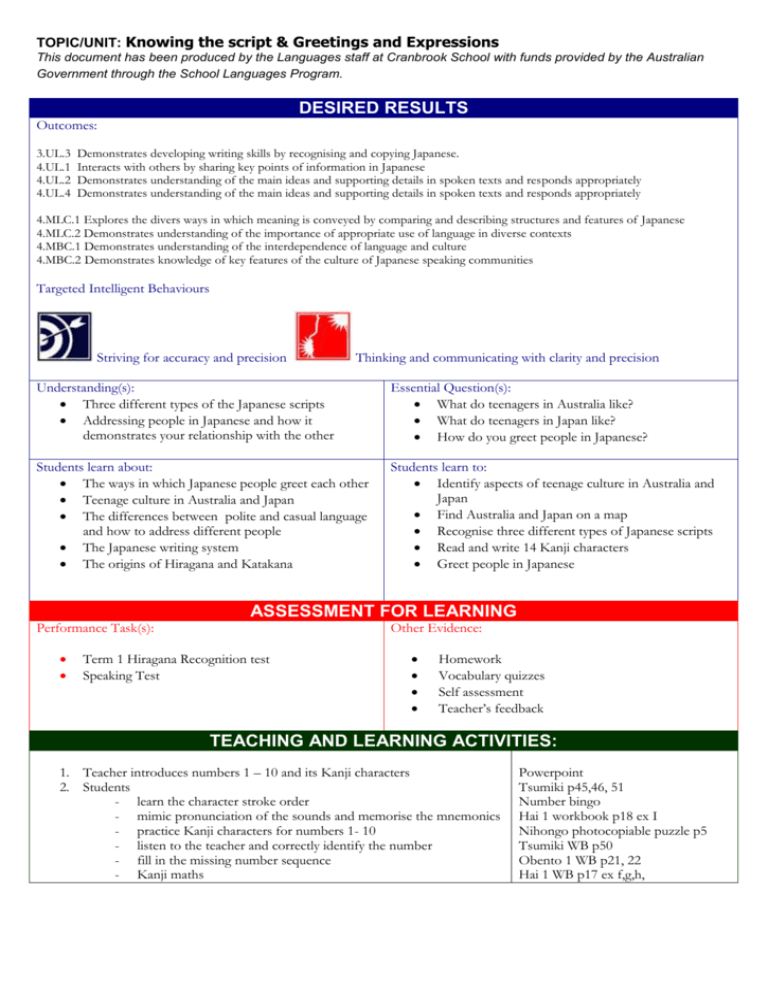
TOPIC/UNIT: Knowing the script & Greetings and Expressions This document has been produced by the Languages staff at Cranbrook School with funds provided by the Australian Government through the School Languages Program. DESIRED RESULTS Outcomes: 3.UL.3 4.UL.1 4.UL.2 4.UL.4 Demonstrates developing writing skills by recognising and copying Japanese. Interacts with others by sharing key points of information in Japanese Demonstrates understanding of the main ideas and supporting details in spoken texts and responds appropriately Demonstrates understanding of the main ideas and supporting details in spoken texts and responds appropriately 4.MLC.1 Explores the divers ways in which meaning is conveyed by comparing and describing structures and features of Japanese 4.MLC.2 Demonstrates understanding of the importance of appropriate use of language in diverse contexts 4.MBC.1 Demonstrates understanding of the interdependence of language and culture 4.MBC.2 Demonstrates knowledge of key features of the culture of Japanese speaking communities Targeted Intelligent Behaviours Striving for accuracy and precision Thinking and communicating with clarity and precision Understanding(s): Three different types of the Japanese scripts Addressing people in Japanese and how it demonstrates your relationship with the other Essential Question(s): What do teenagers in Australia like? What do teenagers in Japan like? How do you greet people in Japanese? Students learn about: The ways in which Japanese people greet each other Teenage culture in Australia and Japan The differences between polite and casual language and how to address different people The Japanese writing system The origins of Hiragana and Katakana Students learn to: Identify aspects of teenage culture in Australia and Japan Find Australia and Japan on a map Recognise three different types of Japanese scripts Read and write 14 Kanji characters Greet people in Japanese ASSESSMENT FOR LEARNING Performance Task(s): Other Evidence: Term 1 Hiragana Recognition test Speaking Test Homework Vocabulary quizzes Self assessment Teacher’s feedback TEACHING AND LEARNING ACTIVITIES: 1. Teacher introduces numbers 1 – 10 and its Kanji characters 2. Students - learn the character stroke order - mimic pronunciation of the sounds and memorise the mnemonics - practice Kanji characters for numbers 1- 10 - listen to the teacher and correctly identify the number - fill in the missing number sequence - Kanji maths Powerpoint Tsumiki p45,46, 51 Number bingo Hai 1 workbook p18 ex I Nihongo photocopiable puzzle p5 Tsumiki WB p50 Obento 1 WB p21, 22 Hai 1 WB p17 ex f,g,h, 3. Teacher introduces and explains the Japanese writing system 4. Students - learn about Kanji, Hiragana and Katakana and their purpose - identify three different types of scripts in a sample advertisement 5. Teacher introduces all 46 Hiragana syllables 6. Students - Learn the 5 basic vowel sounds - Memorise the mnemonics through Hiragana in 48 minutes - Complete filling out the Hiragana chart - Practise writing in Hiragana Workbook - Listen and identify the syllables they hear - Learn the stroke orders - Watch Gun Gun Pera Pera - Complete Hiragana recognition step test 7. Students - research about geography of Japan, and label 4 main islands and major cities of Japan - complete Extension Task listed in Teacher Companion p4 8. Teacher introduces Kanji for 日本人語 9. Students - Practice writing Kanji iiTomo student book p5-7 Kimono 1 WB p12 Obento 1 WB p3 Hai 1 WB p2 ex d,e,f iiTomo AB p6 Hiragana in 48 minutes Various Youtube Hiragana songs Hiragana booklet Gun Gun Pera Pera episode 1 iiTomo SB p4 iiTomo AB p4,5 iiTomo AB p7 Teacher produced Kanji sheet 10. Students - List five items important to them and compare with that of a Japanese teenager - Class discussion on questions asked about Japanese & Australian Teenagers - Make a small poster by drawing themselves with a five speech bubble - Differentiate the word 女の子、男の子 - Create an electronic collage of Japanese culture by completing Skill Builder questions listed in Teacher Companion p 3. iiTomo SB p2,3 iiTomo AB p1,2,13 11. Teacher introduces basic greetings and expressions おはよう・おはようございます・こんにちは・こんばんは・おやすみな さい・さようなら・またあした・すみません・ありがとう・どうぞ・ はじめまして・どうぞよろしく・せんせい・~くん、~さん 12. Students - Mimic the pronunciation of the sounds - Match the illustration with its correct greeting - Complete quiz - Class discussion 13. Students - learn about common Japanese boys’ and girls’ names - practice how to introduce themselves using correct manner RESOURCES Kimono 1 WB p1,2 Ima 1 WB p46 Hai 1 WB p1 ex a,b,c Hai 1 WB p11 ex k iiTomo AB p11,12, 14 Teacher produced worksheets iiTomo 1 p8 iiTomo 1 Chapter 1 Student and Activity book iiTomo audio CDs iiTomo 1 Teachers Companion Pearson Places worksheets Gun Gun Pera Pera Hiragana in 48 minutes Teacher produced Hiragana booklet Teacher produced Term 1 booklet TEACHER EVALUATION
